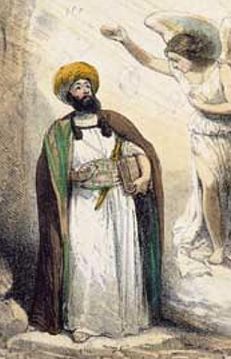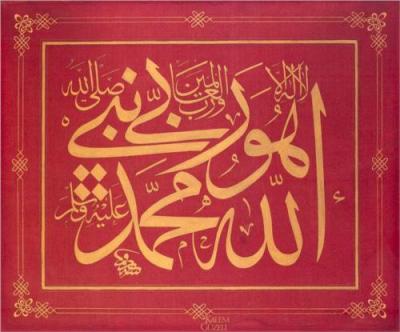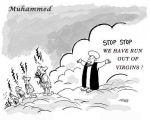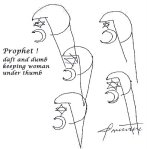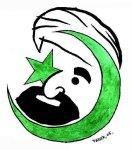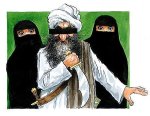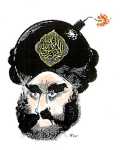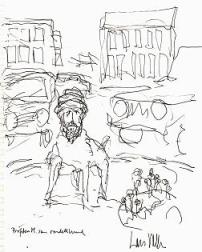An example of one of the earliest modern controversies in depicting Mohammad, Die Berufung Mohammeds durch den Engel Gabriel by Theodor Hosemann was published by the German newspaper Der Spiegel in 1999. This resulted in protests, as well as Der Spiegel receiving threats. However, this would only be a taste of things to come. Over the course of the next ten years it would come to pass that dozens had died, thousands had been injured and countless venues of free expression stifled due to the fear of Islamic extremism. And for what? Depictions of Mohammad.
You see, Islam has a theological belief in aniconism. This essentially means “no images,” from the Greek εικων and the prefix an, meaning no. As in no pictures of Mohammad. Like the one right here or any of the following. Yes, no pictures of Mohammad indeed. While this is a pervasive belief in Islam, it is not found within the Qur’an itself, but rather in the hadith, such as the Ṣaḥīḥ al-Bukhārī. A depiction of Mohammad is a sin on two accounts – it is blasphemy and it is idolatry. This is why you will rarely find depictions of Mohammad within Islamic history and art (although there are a good number of exceptions, particularly within Sufism). You will rarely even find artwork depicting animals or other living creatures. Instead, Islamic art often takes the form of geometry or calligraphy. A classic example is the name of Allah and Mohammad on the left, by Mustafa Rakim.
And then we have Submission, Part I, by the late Theo van Gogh and the ever beautiful Ayaan Hirsi Ali:
If Theodor Hosemann’s benign depiction of Mohammad being visited by Gabriel was too racy for the Islamic world, Submission was definitely pushing it. In 2004, Theo van Gogh and Ayaan Hirsi Ali created this short film. The film depicts four Muslim women who have been victims of abuse common in Islamic society, permitted by Islamic law (some of which Ayaan Hirsi Ali herself was a victim of, and witnessed among family members, as she wrote in her autobiography Infidel). Theo van Gogh was subsequently assassinated; shot in broad daylight along with two innocent bystanders, van Gogh was partially decapitated and a letter, threatening Ayaan Hirsi Ali, was pinned to his body with a knife. Subsequent presentations of Submission, Part 1, such as that planned in support of freedom of expression at the Rotterdam Film Festival, were canceled due to fears of violence. Submission, Part II was never made.
- Cartoonist
- We Have Run Out Of Virgins
- Death Under the Thumb of Islam
- PR Stunt
- PR Stunt 2
- Mohammad Preaching
- Lineup
- Mohammad’s Glory
- Crescent
- Censored
- Mohammad Bomb Turban
In 2005, Flemming Rose, an editor for the Danish newspaper Jyllands-Posten commissioned twelve cartoons satirizing Mohammad to protest a difficulty finding artists to illustrate a book about Mohammad. Illustrators were refusing work due to fears of violent reprisal. The publication of the twelve cartoons above resulted in violent protests worldwide, death threats and even terror plots. A Pakistani political party allegedly offered a $10,000 reward to kill any one of the cartoonists. The Iraqi Mujahideen Army made a call for terror attacks against Danish targets. Multiple arrests were made over attempted attacks and terror plots in response to the cartoons. These included plans to use a remote controlled car rigged with explosives and an attempt to murder Kurt Westergaard, one of the cartoonists, in his own home with an ax.
In 2006, the Deutsche Opera Berlin canceled a performance of Mozart’s opera Idomeneo, re di Creta due to what was described as an “incalculable security risk.” In the opera, King Ideomeno displays the severed heads of Neptune, Jesus, Buddha and Mohammad. Anonymous threats followed the first production of Ideomeno, resulting in the cancellation of following performances.
In 2007, Bangladeshi cartoonist Arifur Rahman published a short cartoon strip in the Bengali-language Prothom Alo. The dialogue says verbatim, “What is your name?” “Babu.” “It is customary to put Mohammad before your name. What is the name of the cat?” “Mohammad the cat.” Although Mohammad was not depicted, it was viewed as severely offensive to call a cat Mohammad. Raham was arrested and Muslims around Bangladesh called for the death penalty, the traditional punishment for blasphemy. This also resulted in multiple violent protests.
In 2010, French newspaper Charlie Hebdo had its office firebombed and it website hacked for releasing a satirical picture of Mohammad. A similar cartoon run by Charlie Hebdo, under the title Intouchables 2, proved the assertion. When Charlie Hebdo released a “halal” comic book about the life of Mohammad, one worked upon by various Islamic scholars, this too was condemned. The idea being, again, that Mohammad’s life itself was too sacred to depict and that to do so would be tantamount to blasphemy.
The depiction of Mohammad on the left was the first presentation of Mohammad in Charlie Hebdo, titled Charia Hebdo as a play on sharia, or Islamic law. Incidentally, it is the common interpretation of sharia, Islamic law, that prohibits the depiction of Mohammad. A difficult conception may be that while we tend to distinguish between religious and secular laws in most of the Western world (aside from fundamentalist zealots of all religions), this distinction is far less pronounced in Islam.
Swedish artist Lars Vilks published three drawings of Mohammad depicted as a dog in Nerikes Allehanda. These were alongside an editorial on freedom of religion. These drawings were referenced as a motivation for the 2010 Stockholm bombings. Additional plots to assassinate Vilks have been uncovered, as well as making Vilks the recipient of numerous death threats. Nerikes Allehanda has increased security due to a high threat level, including hiring personal bodyguards for employees. The governments of Iran, Pakistan, Egypt and Jordan have issued official condemnations – not for the violence, but for the act of publishing the cartoons. Multiple art exhibitions have canceled Lars Vilks’s presentations at the last moment, fearing violence.

Prophet Muhammad Preaching: Folio from the Maqtal-i Al-i Rasul of Lami’i Chelebi, Ottoman period (ca. 1299–1923), late 16th century Turkey or Iraq
Later in 2010, the Metropolitan Museum of Art in New York City removed some sixty pieces of artwork depicting Mohammad from an exhibit on Islam, citing fears of violence. The remaining pieces, previously in an exhibit titled “Islamic Galleries,” were moved to a new exhibit called, “Arab Lands, Turkey, Iran, Central Asia and Later South Asia” to avoid referencing “art” and “Islam” together at all. In 2012, when the Louvre opened its “Islamic Art” exhibit, it posted armed guards to thwart potential violence.
